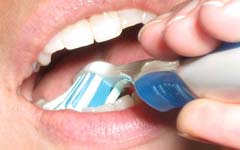While traditional treatments like teeth whitening toothpastes, at-home trays and in-office procedures are an effective way to get there, they can sometimes cause tooth sensitivity and pain. For those hoping to steer clear of chemical treatments, there are a few techniques that can possibly help your smile to sparkle naturally.
The first step is good oral hygiene. “Health and beauty are intertwined” says Arthur Glosman, D.D.S., a cosmetic dentist in Beverly Hills. “If something is healthy, it’s going to look beautiful. If it’s sick, no amount of white teeth is going to make it look good.”
Beyond that, here are a few remedies that do work for a whiter teeth:
Crunchy fruits and vegetables
Crunchy, crispy fruits have an abrasiveness that can help to lift stains from the teeth and give the illusion that they are whiter. "They're like nature's toothbrush"
Try munching on apples, celery and carrots, which have enough abrasiveness to clean tooth surface without posing any harm to the enamel. "The crispier the better"
Flossing
People underestimate how important staining is that happens in between the teeth. If you just floss, you can remove so much of the staining that's in between the teeth that your teeth will already look whiter.
No matter how bleached your teeth are, they won't look healthy set up against red, puffy and receded gums, so continuing to brush at least twice a day on top of a daily flossing is highly recommended.
Cheese, Milk and Yogurt
There's a growing body of evidence indicating that eating a small amount of cheese after a meal can potentially help to prevent tooth decay and promote enamel re-mineralization.
Milk and yogurt keep teeth sparkling and cavity-free because they contain the minerals calcium and phosphorus, which promote the remineralziation of tooth enamel.
Sugar-free gum with xylitol
Xyoltol is a natural sweetener that can actually help to prevent plaque. While plaque feeds on regular sugar, it can't digest xylitol. Xylitol also neutralizes pH levels in the mouth and increases saliva production. Saliva is like the natural cleaner that we have in our mouth and it spills through all of the cracks and crevices.
Bear in mind that this works both ways -- while saliva can wash away food and debris, it can also carry bacteria throughout the mouth, meaning twice daily brushings and low sugar intake are just as important.
Baking Soda (Sodium Bicarbonate)
While there are properties in baking soda that can remove surface stains, it's not the ideal long-term tooth whitener, says Kimberly Harms, D.D.S., consumer advisor for the American Dental Association, as it can be too abrasive on teeth and ultimately damage the enamel (which can actually make teeth appear even darker). Instead, she suggests sticking with whitening toothpaste that has a clinically tested, safe amount of abrasive properties. The American Dentistry Association looks at appropriate abrasiveness levels, among other factors, when handing out their ADA Accepted seals.















